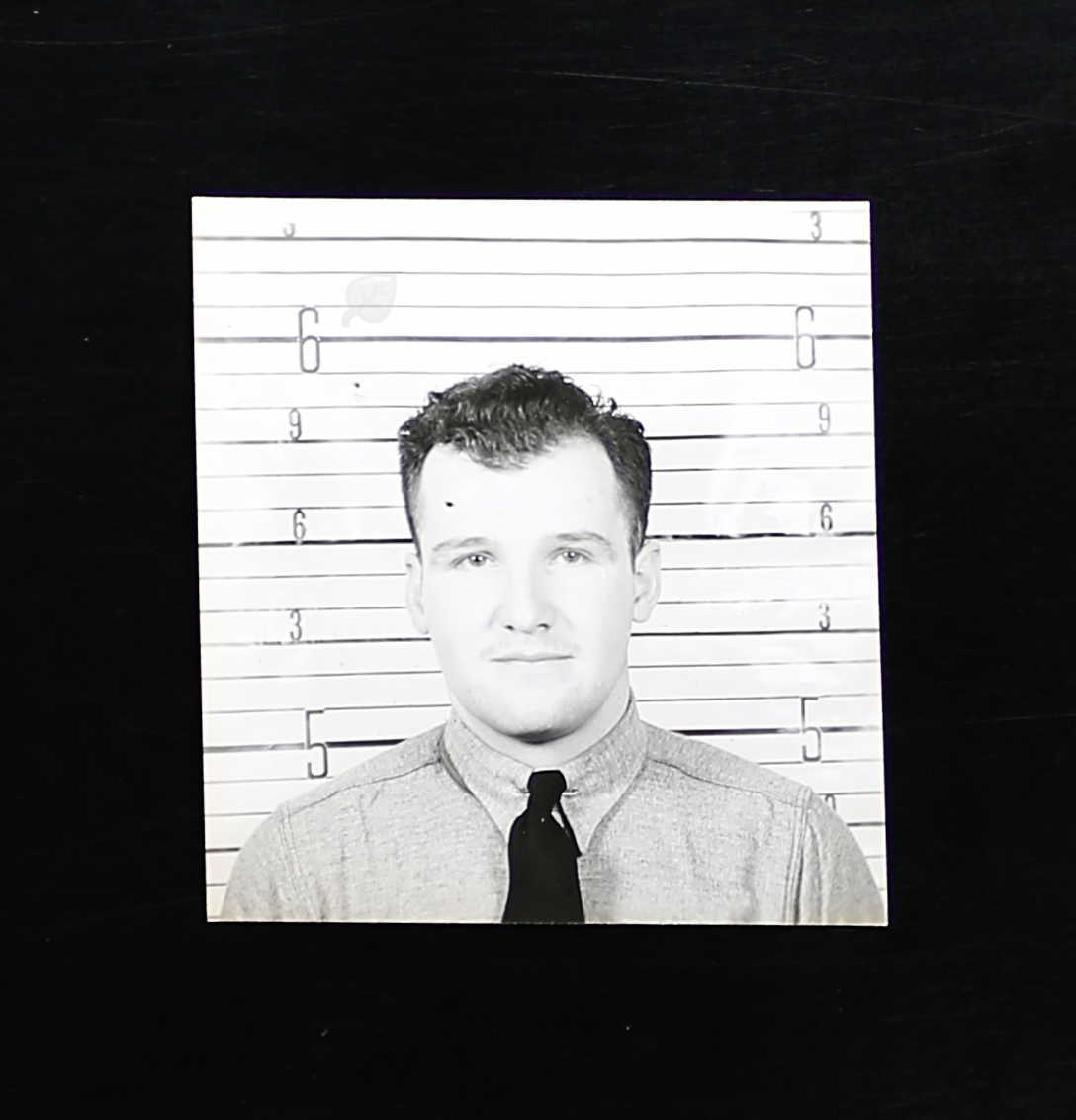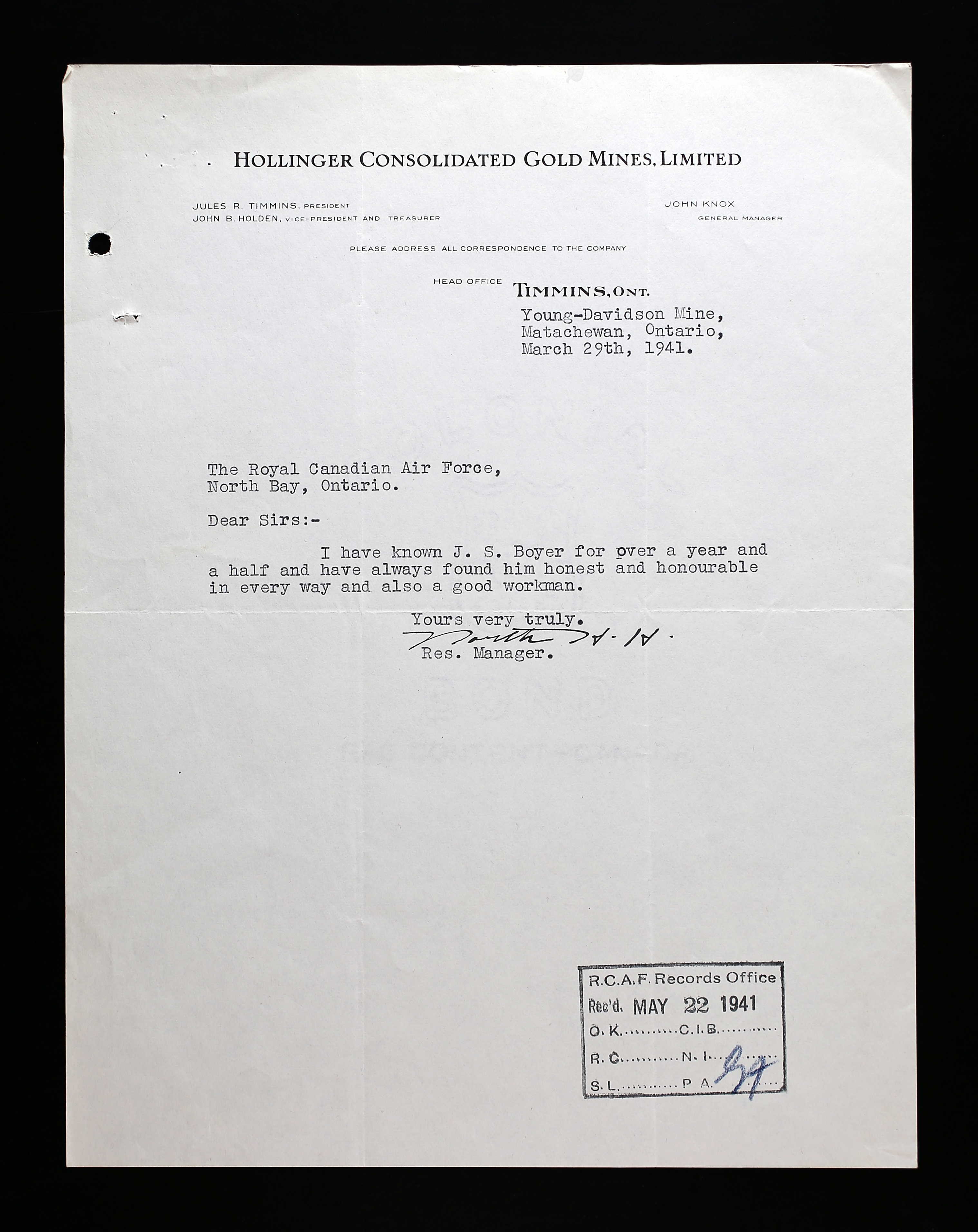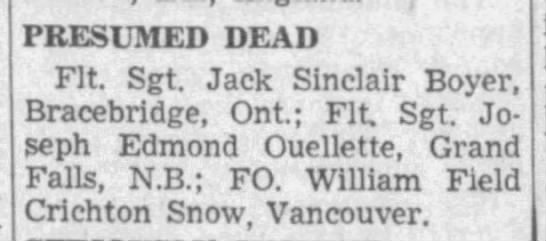



October 6, 1919 - January 28, 1943




Jack Sinclair Boyer was the son of Samuel David Boyer, monumental engraver, (d. 1958) and Caroline Jennifrid (nee Bowyer) Boyer. He had four brothers, Roger, Gilbert, Donald, and Edward, and one sister, Joyce Thelma Topp. Joyce was a CWAC in Ottawa, Roger was overseas as was Donald, and Gilbert, Sergeant, tail gunner RCAF, was killed on April 3, 1943, buried in Uden War Cemetery, Netherlands. The family was Anglican.
He had junior matriculation, with a partial senior. He was a surface worker at the Young-Davidson Mine who enjoyed hockey, basketball, softball, and swimming. He did not smoke but drank the occasional beer.
Jack had enlisted first with the Non-Permanent Active Militia of Canada for the purpose of joining the RCAF. He had 59 days’ worth of training between March 20 and May 17, 1941, North Bay, Ontario.
He stood 5’ 9 ½” tall, weighing 184 pounds. “Real husky lad. Intelligent, little on slow side, but very willing. Keen to be a pilot.” In November 1940, it was noted Jack was overweight, some muscular, some obesity. He lost ten pounds by March 1941. He was accepted into the RCAF in May 1941. “Choice 1. Pilot. 2. Observer. 3. ? Good average material for P or O.” Other comments: “Balancing improved. Pulses still fast. General condition is good. Is apparently nervous about this test.”
His assets included $5.00 at the Bank of Nova Scotia in Bracebridge, Ontario, $35 worth of War Savings Certificates, and some Victory Loan Bonds. He also had a life insurance policy. Jack’s father was the beneficiary of his estate.
Jack started his journey through the BCATP at No, 1 Manning Depot, Toronto from May 28 to June 9, 1941, then he was sent to No. 6 B&G School, Mount View, Ontario before being sent to No. 5 ITS.
At No. 5 ITS, Bellville, Ontario, Course 33, August 8, to September 24, 1941: “Very dependable type, self-conscious but hard worker and should make good.” He was 121 out of 224 in class with an 83%.
At No. 12 EFTS, Goderich, Ontario, from September 25 to November 12, 1941: “This man is not pilot material. His air work is average but when he comes near or in contact with the ground, he loses all sense of judgement. He tightens up on the controls on the takeoffs and makes no attempt to keep the aircraft straight. On the landings, he levels off nicely and then hauls the control column back leaving the aircraft with its nose high in the air and stalled making no attempt to put on motor and get the nose down to get flying speed. With the amount of dual this man has on a takeoff and landings; he does not show normal progress.” General remarks: “When tested, this student’s general flying was very poor. His takeoffs and landings are bad and he has no idea of airmanship. He is good at ground school and is excellent service material.”
Jack was sent to KTS, Trenton until the RCAF found a place for him. They decided Jack would become a navigator and was sent to No. AOS, Ancienne Lorette, Quebec November 23, 1941, until February 28, 1942.
At No. 9 B&G School, Mont Joli, Quebec from March 3 to April 11, 1942: “Good bomb-aimer. Below average in gunnery. General: A good man inclined to practical work.” Jack was awarded his Air Observer’s Badge on April 11, 1942, sent on to No. 2 ANS.
At No. 2 ANS, Penfield Ridge, NB, April 13 to May 11, 1942: “Ground: an erratic student tends to become rattled under exam pressure. Air: A low average man in the air. Did not show much improvement. His confidence in astro is doubtful. Should be watched at O.T.U.” His final assessment: “Straightforward and honest. Popular with his fellow students.”
By mid-May, 1942, Jack was in Halifax and then posted to 145 Squadron, Torbay, Newfoundland June 12, 1942.
On January 28, 1943, Hudson 760, No. 145 Squadron, crew F/O William Field Creighton Snow, Captain, J10517, F/O R. R. Barnes, WAG, J12549, F/Sgt Jack Sinclair Boyer, Navigator, R90741, and F/Sgt Joseph Edmond Ouellette, WAG, R84524, took off for a routine convoy patrol. Snow had about six months on convoy duty and was assessed as an average pilot. Observer was in nose, pilot in position, WO between spars and 2nd WAG in co-pilot’s seat. Four -250-pound depth charges were on board as were four Brownings, fully loaded. This aircraft was detailed to provide protection to an east-bound convoy which was in a danger area.
Memo: “A/C dived into the sea and blew up on contact two miles ahead of convoy and 200 miles from base. Bodies not recovered.”
A Court of Inquiry was struck, and fifteen witnesses were called. F/O L. T. Ross, pilot in the convoy noted that his crew had contacted the convoy escort, exchanging recognition signals, experiencing considerable difficulty in counting the ships in the convoy due to poor visibility. The sea was very rough and the air above the sea was also very rough. There were snow squalls, fog and intermittently poor visibility and bumpy air conditions.
Description of Flight: “F/O Snow and crew of three took off in Hudson 760 at 0935 hours authorized to carry out a routine convoy patrol. Aircraft was to pick up the convoy approximately 170 miles east of base. As no word was received at base from Hudson 760 since takeoff, a signal was transmitted requesting the position. No reply and no further word were received from Hudson 760. At approximately 1135 hours, persons [Navy] on the escort of the convoy saw an aircraft crash about 2 miles ahead of them and saw a bomb or depth charge explode when aircraft struck the water. There were no survivors. The senior officer of the escort reported by signal the text of which was as follows: “Height 100 to 200 feet. Course NW, a/c banked to starboard away from wind, flattened out on course of 050 degrees and plunged nose first into the sea. Machine looked unsteady but no distress signal. Had recently passed call signs by V/S on request. Snow squalls, 3 miles rough sea; air temperature 26F.” Searching aircraft were dispatched but no trace of the missing aircraft and occupants was found and nothing had since been heard of from Hudson 760 and its crew.
“Maintenance to the effect that about January 10th 1943, Hudson 760 was brought into maintenance squadron with a report that the air crew anti-icer system was not functioning. Upon investigation it was found that the piping system was completely plugged up by a gummy substance with about the same consistency as thick mud, and there are also certain definite signs of corrosion inside the tank and pipelines. A sample of this deposit was sent to Government laboratories for analysis which disclosed the substance was probably hydrochloric acid. The anti-icer system and tank from this aircraft were removed and completely replaced by new parts. The system was flushed through and checked and found to be perfectly serviceable.”
FINDINGS OF THE COURT: A. Failure of one or both engines. B. Failure of fuel supply in one tank and the momentary distraction of the pilot’s attention from his instruments while changing over to another tank may have caused a stall, or a stall may have been caused during a turn downwind. Carburetor icing does not appear to be involved. The Court finds that the occupants of Hudson 760 were on Air Force duty when they crashed into the sea; they are missing and must be presumed dead.”
“Scene of crash not visited because it was unknown. Approximate locality in ocean known only. Until more detailed information of aircraft’s attitude at time of crash is received, it is not possible to even hazard a guess as to cause of crash. Cause of depth charged exploding is not clear unless they were torn loose from carriers on impact.”
For full account, please visit https://heritage.canadiana.ca/view/oocihm.lac_reel_t12340/4778?r=0&s=2